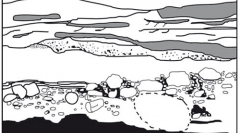

 Geodiversitas
28 (2) - Pages 297-317
Geodiversitas
28 (2) - Pages 297-317A recent survey near the eastern margin of the Perrier Plateau (Puy-de-Dôme, France) has led to the rediscovery of the latest Villafranchian fauna of Peyrolles. This locality was discovered in the 19th century and is recognized as the international biochronological reference for this interval of the Villafranchian (MNQ 19). So it is younger than Senèze (Haute-Loire, France) and probably coeval with the Upper Valdarno locality (Tuscany, Italy). The fossils occur at the top of a fluviatile sequence including reworked trachytic pyroclastites from the Mont-Dore strato-volcano (Puy-de-Dôme, France). The fauna contains four mammals, including three ruminants: Leptobos cf. etruscus, Eucladoceros sp. and “Cervus” perolensis. The last species is the most common. An unidentified mammal comparable in size to a rhinoceros has also been recovered. The flora contains deciduous trees, such as oak, and conifers, such as cedar; this association is also known from the middle Villafranchian site of Saint-Vallier (Drôme, France).
Mammalia, Cervidae, early Pleistocene, latest Villafranchian, Peyrolles, France, pollens